
An electropneumatic paintball marker is a paintball marker that uses a pneumatic solenoid to actuate the hammer and/or bolt's movement.

An electropneumatic paintball marker is a paintball marker that uses a pneumatic solenoid to actuate the hammer and/or bolt's movement.
The origin of the electropneumatic paintball marker is the subject of a patent dispute, [1] but is generally acknowledged to have happened more or less simultaneously with the introduction of WDP's Angel and PneuVenture's Shocker, marketed by Smart Parts, both in 1996. The markers were operated differently; they were similar only to the extent that they both make use of one or more microswitch-controlled solenoid valves.
The Shocker used two solenoid-operated control valves in order to obtain separate controls over the ball loading sequence and the air delivery sequence. The Angel made use of a linked hammer and bolt assembly, which permitted the use of a single solenoid to actuate the entire firing sequence by controlling a piston that powered the hammer/bolt assembly forward, simultaneously chambering a paintball and releasing the propulsion gases at the end of the hammer's stroke.
The twin-solenoid arrangement of the Shocker permitted slightly lower operating pressures to be used, however the drastically simpler arrangement of the Angel provided a faster firing sequence, which ultimately proved to be favored by the players and as a result the basic operating principle behind the Angel has remained unchanged (indeed, it has even been copied many times over by a series of "stacked tube electros"), whereas the Shocker has gone through a series of revisions that culminated in a complete redesign in 2003, and now uses a single solenoid powering the increasingly popular mechanical configuration known as a "spool bolt".
It is also worth noting that while these two markers essentially tied for first electropneumatic markers to market, both designs were pre-dated (by years in some cases) by a series of homemade electropneumatic "kits" that modified pre-existing markers such as the Autococker or Sterling.
The increased availability and use of these markers also encouraged a movement that had already been chafing at the previous technology advances of paintball. These players desired a return to the days of pump markers, ten round capacity, and 12-gram CO2 "powerlets". The movement eventually became what is known today as "Stock-Class Paintball".[ citation needed ]
The Angel and the Shocker exacerbated a fundamental problem that had been brewing in the sport—as markers got quieter, with less vibration and kick, the vibration that used to keep paintballs from jamming in the hopper feedneck went away. The solution was a move to motorized loaders, most notably the ViewLoader Revolution, which used a paddle to agitate the balls whenever an infrared beam in the feedneck became uninterrupted.
However, the reality of gravity set in, and it was obvious that to satisfy the appetites of the modern marker, the loader manufacturers were going to need to force the paintballs down the feedneck faster than mere gravity would allow. As a result, modern markers now feature Empire's Reloader B2 and MagnaDrive, Dye's Rotor, ViewLoader's VLocity, Odyssey's Halo, The Q-Loader and the Draxxus Pulse systems, each feeding at rates of 22 balls-per-second or more.
Two main ball-detection systems were created to ensure that a ball is present in the chamber when the player pulls the trigger. These systems were needed because, even as the loaders fed paint ever-faster into the markers, so too did the markers develop shorter firing cycles and more responsive electronics. Descriptions of the two BDS's and their subtypes follow:
Makes use of an infrared emitter and receiver to detect the presence of a ball based on whether or not a ball in the feed tube blocks a beam from reaching a receiver on the opposite side.
Detects whether a ball is present based on amount of emitted light reflected back to a sensor.
Detects the presence of a ball based on force applied to a rod at the base of the chamber, which converts that force to an electrical signal via a piezoelectric "pad".
Makes use of a rod extending up into the firing chamber and resting against the base of a chambered ball. The rod is oscillated at an extremely high frequency (imperceptible to humans) by a crystal on the control board, and when a ball falls into the chamber and hits the rod, the oscillation is affected, allowing the marker to detect when the ball is fully chambered.
As COPS, above, but the calibration of the software to detect ball presence is automatic. Sensi incorporates an LDS (Load Detection System) that allows it to detect presence of balls further up the stack, occasionally allowing exceedingly-fast performance when it detects a full, pressured stack.
Using electronic "ears" hoppers will "listen" for the marker to fire and feed the next ball accordingly. This saves batteries if the hopper is left on, and since it does not require an "eye," it does not run the risk of impaired performance due to a dirty or obstructed sensor.
Although it stops excess battery use, when in an intense firefight, with nearby players, the hopper might load accidentally as the reports of other markers can deceive the sound sensor.

A machine gun is a fully automatic, rifled auto-loading firearm designed for sustained direct fire with rifle cartridges. Other automatic firearms such as automatic shotguns and automatic rifles are typically designed more for firing short bursts rather than continuous firepower and are not considered true machine guns. Submachine guns fire handgun cartridges rather than rifle cartridges and thus are not considered machine guns, while automatic firearms of 20 mm (0.79 in) caliber or more are classified as autocannons rather than machine guns.
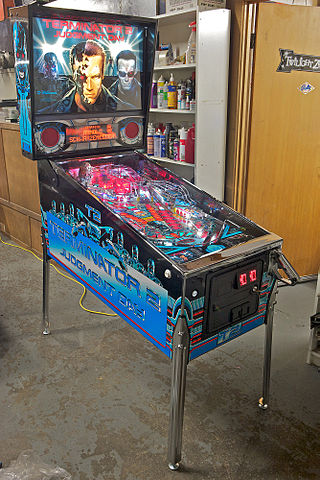
Pinball games are a family of games in which a ball is propelled into a specially designed table where it bounces off various obstacles, scoring points either en route or when it comes to rest. Historically the board was studded with nails called 'pins' and had hollows or pockets which scored points if the ball came to rest in them. Today, pinball is most commonly an arcade game in which the ball is fired into a specially designed cabinet known as a pinball machine, hitting various lights, bumpers, ramps, and other targets depending on its design. The game's object is generally to score as many points as possible by hitting these targets and making various shots with flippers before the ball is lost. Most pinball machines use one ball per turn, and the game ends when the ball(s) from the last turn are lost. The biggest pinball machine manufacturers historically include Bally Manufacturing, Gottlieb, Williams Electronics and Stern Pinball.

In firearms terminology, an action is the functional mechanism of a breech-loading firearm that handles the ammunition cartridges, or the method by which that mechanism works. Actions are technically not present on muzzleloaders, as all those are single-shot firearms with a closed off breech with the powder and projectile manually loaded from the muzzle. Instead, the muzzleloader ignition mechanism is referred to as the lock.
Tippmann is an American manufacturer of paintball markers and paintball equipment, including military simulation (MilSim) kits. A related company, Tippmann Industrial Products manufactures manual and pneumatic heavy-duty sewing machines primarily used for leather, other leather-related equipment, and some industrial products. Originally a family-owned business run from Fort Wayne, Indiana, in 2004 Dennis Tippmann Sr. sold a majority ownership stake to Summit Partners, a private equity firm. Tippmann designed one of the first automatic markers, the use of refillable air systems in place of 12 gram cartridges, the "Cyclone Feed" system, the "Flatline" barrel, and the Tippmann C-3, the first propane-powered marker.
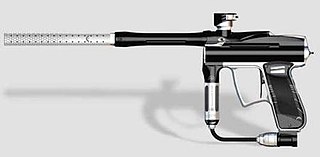
The Angel is one of the first electropneumatic paintball markers. It was manufactured by Angel Paintball Sports starting in 1997 and was introduced alongside Smart Parts' original Shocker.
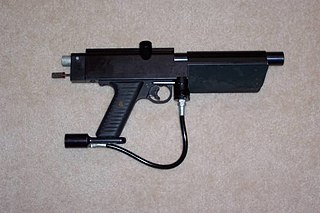
The Autococker is a closed-bolt semiautomatic paintball marker manufactured by Worr Game Products (WGP). It was one of the first paintball markers to be designed specifically for the sport, and has long been known throughout the paintball community for its popularity and customizability as well as its complexity. It is commonly believed that the closed-bolt design of the marker makes it inherently more accurate than its open-bolt counterparts, though this is disputed.
Smart Parts was a paintball manufacturing company in Latrobe, Pennsylvania, which filed for liquidation on July 28, 2010. As of August 22, 2010 Smart Parts' assets and intellectual property were acquired by Kee Action Sports.

A paintball marker, also known as a paintball gun, paint gun, or simply marker, is an air gun used in the shooting sport of paintball, and the main piece of paintball equipment. Paintball markers use compressed gas, such as carbon dioxide (CO2) or compressed air (HPA), to propel dye-filled gel capsules called paintballs through the barrel and quickly strike a target. The term "marker" is derived from its original use as a tool for forestry personnel to mark trees and ranchers to mark wandering cattle.
Paintball is an equipment-intensive sport and in order to safely conduct a game, every player requires a marker with propellant to fire the paint, a mask to protect the eyes and face, paintballs, and a loader to hold them. To ensure safety off the playing field, a barrel sock or plug for the marker is also compulsory.
A ball detent is a simple mechanical arrangement used to hold a moving part in a temporarily fixed position relative to another part. Usually the moving parts slide with respect to each other, or one part rotates within the other.
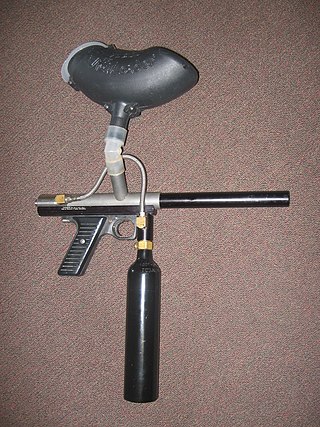
The Automag is a paintball marker designed by Tom Kaye and produced by Airgun Designs, Inc. It bears the distinction of being the first semi-automatic marker ever to win a paintball tournament. Team Swarm used Automags in their victory at the 1990 International Masters.
A transmission control unit (TCU), also known as a transmission control module (TCM), or a gearbox control unit (GCU), is a type of automotive ECU that is used to control electronic automatic transmissions. Similar systems are used in conjunction with various semi-automatic transmissions, purely for clutch automation and actuation. A TCU in a modern automatic transmission generally uses sensors from the vehicle, as well as data provided by the engine control unit (ECU), to calculate how and when to change gears in the vehicle for optimum performance, fuel economy and shift quality.
The Quadrajet is a four barrel carburetor, made by the Rochester Products Division of General Motors. Its first application was the new-for-1965 Chevy 396ci engine. Its last application was on the 1990 Oldsmobile 307 V8 engine, which was last used in the Cadillac Brougham and full size station wagons made by Chevrolet, Pontiac, Oldsmobile, and Buick.
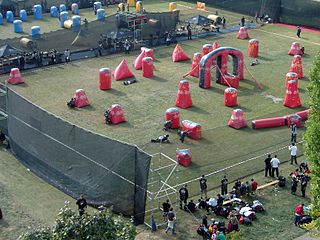
Speedball is one of the three distinct game variants in the sport of paintball, along with woodsball and scenario paintball.
The CCI Phantom is a Nelson-based pump action paintball marker developed and produced by Mike Casady. Production began in 1987 after about six months of prototype work. The name for the marker was derived from the much more stealth-oriented and drawn-out style of play that was typical when the game was first developing. The Phantom was designed to be powered by a single 12-gram CO2 Powerlet, but larger tanks may also be used by removing the powerlet adapter or using a dummy powerlet. When first introduced the marker featured a fixed barrel assembly referred to as a "unibody" combined with a modified Crosman air pistol frame and brass bead sight. However, since roughly 1989 the body and barrel of the marker have been two distinct parts and no longer feature the bead style sight. The marker is also capable of supporting bulk gravity fed hoppers by using a different breach type. The Phantom is one of only a handful of readily available markers acceptable for use in the various forms of stock class paintball. However, because the Phantom is capable of auto-triggering and features barrel porting it is considered to be a modified stock class marker.

The Ion is an electropneumatic paintball marker manufactured by Smart Parts. At the time of its release, the Ion was the first fully electropneumatic marker aimed at entry-level players, at a price point similar to Spyders and other mechanical blowbacks. The Ion has generally been credited with making high-rate-of-fire electropneumatic markers generally available, at a time when electropneumatic markers were considered out of reach of most casual or budget players.
WDP PAINTBALL LTD owns and operates NPF Bassetts Pole Adventure Park, a paintball site / adventure park in Birmingham., England. The company WDP is also known for manufacturing the Angel line of electropneumatic paintball markers.
A shutdown valve is an actuated valve designed to stop the flow of a hazardous fluid upon the detection of a dangerous event. This provides protection against possible harm to people, equipment or the environment. Shutdown valves form part of a safety instrumented system. The process of providing automated safety protection upon the detection of a hazardous event is called functional safety.
RAP4 is a manufacturer of paintball markers, paintball equipment, tactical gear and training tools.
In engineering, a solenoid is a device that converts electrical energy to mechanical energy, using an electromagnet formed from a coil of wire. The device creates a magnetic field from electric current, and uses the magnetic field to create linear motion. In electromagnetic technology, a solenoid is an actuator assembly with a sliding ferromagnetic plunger inside the coil. Without power, the plunger extends for part of its length outside the coil; applying power pulls the plunger into the coil. Electromagnets with fixed cores are not considered solenoids. In simple terms, a solenoid converts electrical energy into mechanical work. Typically, it has a multiturn coil of magnet wire surrounded by a frame, which is also a magnetic flux carrier to enhance its efficiency. In engineering, the term may also refer to a variety of transducer devices that convert energy into linear motion, more sophisticated than simple two–position actuators. The term "solenoid" also often refers to a solenoid valve, an integrated device containing an electromechanical solenoid which actuates either a pneumatic or hydraulic valve, or a solenoid switch, which is a specific type of relay that internally uses an electromechanical solenoid to operate an electrical switch; for example, an automobile starter solenoid or linear solenoid. Solenoid bolts, a type of electromechanical locking mechanism, also exist.